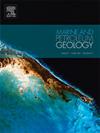哥伦比亚加勒比海北部辐合边缘的瓜希拉等长岩沉积体系
IF 3.6
2区 地球科学
Q1 GEOSCIENCES, MULTIDISCIPLINARY
引用次数: 0
摘要
海底流在沉积物的运输、侵蚀和沉积中起着重要的作用。它们也有能力改变海底的形态。轮廓岩沉积体系在世界范围内已被报道,主要分布在被动边缘;在收敛边缘有几个例子报告。本研究利用区域多波束测深和地震数据,首次在哥伦比亚加勒比海北部辐合边缘的上大陆斜坡上记录了一个~ 20,000 km2的斜坡等高线沉积体系。我们将坡面地貌特征与底流的水动力模拟进行了比较。我们在靠近陆架边缘的上斜坡上发现了面积约2700平方公里的侵蚀阶地和护城河。在这个区域附近,模拟洋流的速度可以达到~ 10厘米/秒。然而,底部洋流具有高度的可变性,在阶地上也发现了~ 1 cm/s的低值;这可能表明,当水流达到其最高循环速度时,侵蚀就会发生。因此,沿坡的侵蚀既不是均匀的,也不是连续的。另一方面,与泥沙堆积相关的灰泥漂移和泥沙波场流速较低,在~ 1 ~ 5 cm/s之间,覆盖了较大的上坡面积(~ 17,600 km2),表明泥沙堆积可能发生在底流流速较低的地区。灰泥漂移厚度在研究区内也表现出较高的变异性。~ 785 ms(或±800 m)的主要厚度与缓坡地形(<2°)有关。相比之下,陡坡地形(>2 - 5°)地区的最低厚度为~ 300 ms(或±300 m),这表明在缓坡地形(<2°),灰泥漂移沉积物具有更大的厚度。这项工作使我们能够首次描述哥伦比亚北部加勒比海边缘的区域斜坡等高线沉积体系,并强调了底流强度和斜坡梯度地形在控制低沉积物供应的活动边缘的侵蚀和沉积物优先堆积方面的影响。这种产状模式可能是世界范围内河流输沙量较低的辐合边缘的等长岩沉积体系发育的特征。本文章由计算机程序翻译,如有差异,请以英文原文为准。
The Guajira contourite depositional system along the northern Colombian Caribbean convergent margin
Bottom currents have a significant role in the transport, erosion and deposition of sediments. They also have the power to modify the seabed morphology. Contourite depositional systems have been reported worldwide, mainly in passive margins; with few examples reported at convergent margins. This study uses regional multibeam bathymetry and seismic data, to document for the first time a∼20,000 km2 slope contourite depositional system along the upper continental slope of the northern Colombian Caribbean convergent margin. We compare the characteristics of the slope geomorphology with hydrodynamic modeling of the bottom currents. We identified on the upper slope, close to the shelf edge, the presence of erosional terraces and moats over an area of∼2,700 km2. Near this sector, the modelled ocean currents can reach speeds of up to∼10 cm/s. However, the bottom currents have a high degree of variability, and low values of∼1 cm/s are also identified over the terraces; this may suggest that erosion can occur when the currents reach their highest speeds of circulation. Therefore, the erosion is neither homogeneous nor continuous along the slope. On the other hand, the plastered drift and sediment wave fields related to sediment accumulation have low current velocities between∼1 - 5 cm/s, and they cover a large area of the upper slope (∼17,600 km2), suggesting that sediment accumulation may occur in areas where bottom currents have low velocities. The plastered drift thickness also shows high variability in the study area. The major thicknesses of∼785 ms (or ± 800 m) are related to a gentle slope topography (<2°). In contrast, the lowest thicknesses of∼300 ms (or ± 300 m) are identified in areas with steep slope topography (>2–5°), indicating that in gently slope topography (<2°) plastered drift deposits have a greater thickness. This work allows us to characterize for the first time a regional slope contourite depositional system along the northern Colombian Caribbean margin and highlights the influence of bottom current strength and slope gradient topography in controlling the erosion and preferential accumulation of sediments in an active margin with low sediment supply. This mode of occurrence may be characteristic of contourite depositional system development on convergent margins with low fluvial sediment discharge worldwide.
求助全文
通过发布文献求助,成功后即可免费获取论文全文。
去求助
来源期刊

Marine and Petroleum Geology
地学-地球科学综合
CiteScore
8.80
自引率
14.30%
发文量
475
审稿时长
63 days
期刊介绍:
Marine and Petroleum Geology is the pre-eminent international forum for the exchange of multidisciplinary concepts, interpretations and techniques for all concerned with marine and petroleum geology in industry, government and academia. Rapid bimonthly publication allows early communications of papers or short communications to the geoscience community.
Marine and Petroleum Geology is essential reading for geologists, geophysicists and explorationists in industry, government and academia working in the following areas: marine geology; basin analysis and evaluation; organic geochemistry; reserve/resource estimation; seismic stratigraphy; thermal models of basic evolution; sedimentary geology; continental margins; geophysical interpretation; structural geology/tectonics; formation evaluation techniques; well logging.
 求助内容:
求助内容: 应助结果提醒方式:
应助结果提醒方式:


